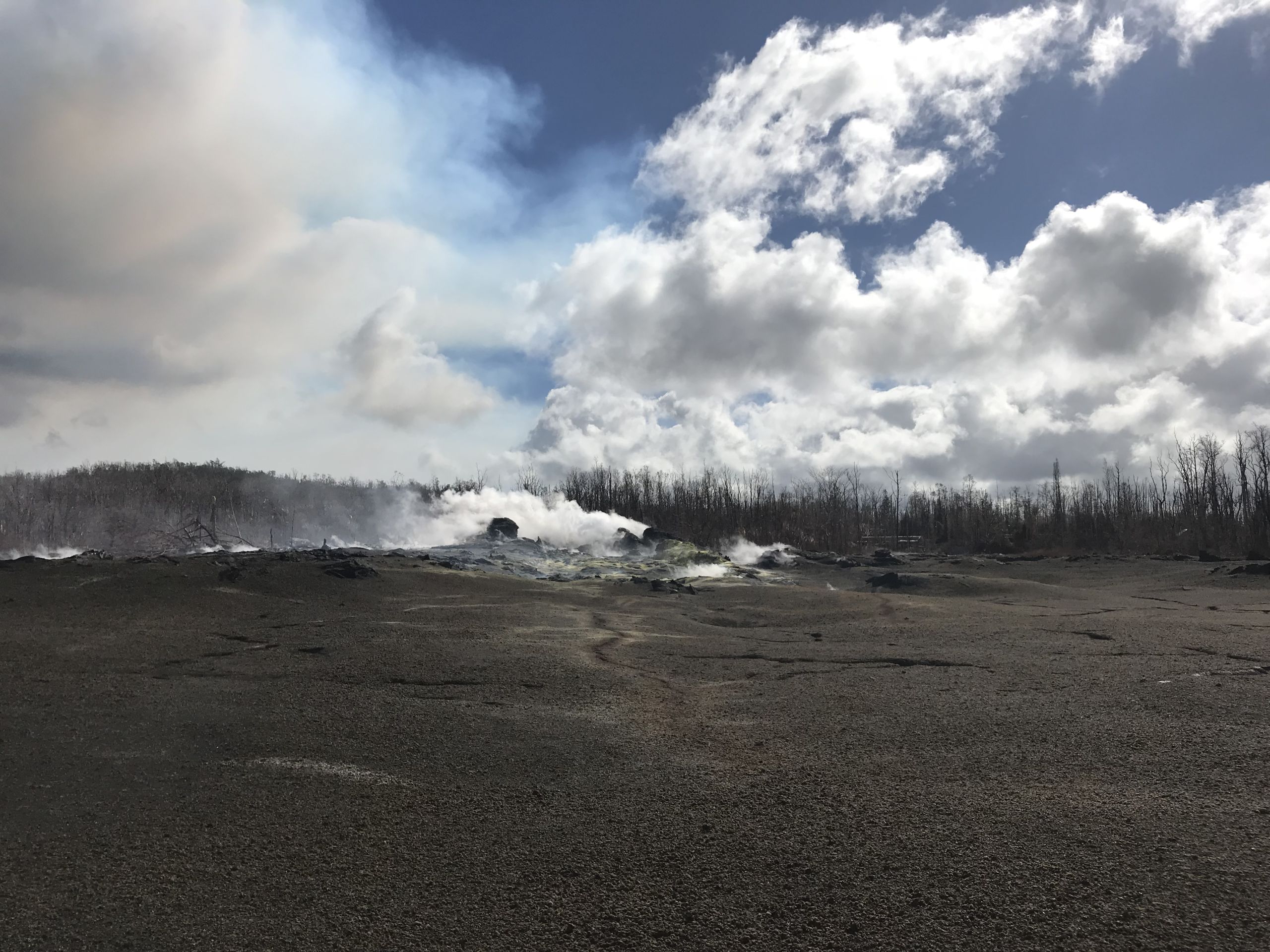The hidden dangers of volcanic pollution: scientists track veil of toxic metals carried in Kīlauea’s gas plumes

A team of volcanologists who observed the colossal 2018 eruption of Kīlauea, Hawai’i, have tracked how potentially toxic metals carried in its gas plumes were transported away from the volcano to be deposited on the landscape.
The research, published in two companion papers in Nature Communications Earth and Environment, is the most extensive survey of metal release from any volcano to date – helping scientists understand the spread of metal-rich volcanic fumes and the exposure of communities to volcanic air pollution around Hawai’i.
The 2018 eruption of Kīlauea was the largest in centuries, flooding the eastern edge of the island with roughly a cubic kilometre of lava. Over a thousand people lost their homes and many more suffered from noxious volcanic gases.
“Understanding how volcanic metals are released to the environment is critical from a public health perspective,” said Emily Mason, PhD student at Cambridge Earth Sciences and lead author of one of the papers. “We don’t know much about these metal emissions at all, so this work is a key step to understanding the significant, yet underestimated, chemical risks of volcanoes.”

USGS scientists working in front of Kīlauea's prominently active Fissure 8 vent. Photo: Emily Mason/USGS
USGS scientists working in front of Kīlauea's prominently active Fissure 8 vent. Photo: Emily Mason/USGS
Volcanic metal emissions: a stealth hazard
When volcanoes erupt they exhale a cocktail of gases – mostly steam, carbon dioxide and sulphur dioxide – laced with evaporated heavy metals, including lead and arsenic. To the communities living alongside volcanoes, these gases are often a considerable source of air pollution and the volatile metals they carry may have long-lasting impacts on both health and environment.
Volcanologists have been measuring volatile metal emissions from volcanoes for decades, but how these elements are dispersed in the atmosphere following an eruption, to later rain down on the landscape and be taken up in the environment through soils and water bodies, has remained poorly understood.
The team, which included researchers from the University of Cambridge, report higher concentrations of airborne heavy metals within a 40 km radius of Kīlauea, meaning that communities living closer to the volcano were disproportionally exposed to metal pollution during the 2018 eruption.
They believe that the strong trade winds at the time of the eruption, combined with the topography of the local area, caused higher rainfall and, therefore metal deposition, closer to the vent. This could mean that an eruption in winter, when wind patterns are reversed, might result in a different distribution of metal deposition.

Their results could help delineate environmental monitoring strategies during and following volcanic eruptions – including the targeted testing of community water supplies in at-risk areas – as well as helping planners decide where to build safely around volcanoes.

On the trail of volcanic metals
Emily Mason was one of an all-female team of scientists from the Universities of Cambridge and Leeds that headed out to take gas measurements when Kīlauea erupted. Mason, together with then first-year PhD students Penny Wieser and Rachel Whitty, and early career scientists Evgenia Ilyinskaya and Emma Liu, arrived when the eruption was in full flow and some of their study area was already cut off by lava, “We had to fly in to one location via helicopter. I remember descending through a dense haze of volcanic gas…the acidic air actually stung our skin.” said Mason.

From left to right: Penny Wieser, Emma Liu, Emily Mason, stand in front of lavas emanating from the Fissure 8 vent in July 2018. Photo: USGS
From left to right: Penny Wieser, Emma Liu, Emily Mason, stand in front of lavas emanating from the Fissure 8 vent in July 2018. Photo: USGS
“We tend to think of the more immediate volcanic hazards like ash fall, pyroclastic flows, lava” said Dr Evgenia Ilyinskaya, from the University of Leeds, who lead the research on downwind metal dispersal, “But metal emissions, just like air pollution, are an insidious and often underestimated volcanic hazard – potentially impacting health over long periods.”







Lava erupting from Fissure 8. Photo: Emily Mason/USGS
Lava erupting from Fissure 8. Photo: Emily Mason/USGS

From left to right: Emily Mason, Penny Wieser, Emma Liu, measuring sulphur dioxide emission rates in the Fissure 8 plume. "We bought matching outfits from Target as we all needed to be in ~100% cotton!" -- Emily Mason. Photo: Frederic (‘Bill’) Simmons/USGS.
From left to right: Emily Mason, Penny Wieser, Emma Liu, measuring sulphur dioxide emission rates in the Fissure 8 plume. "We bought matching outfits from Target as we all needed to be in ~100% cotton!" -- Emily Mason. Photo: Frederic (‘Bill’) Simmons/USGS.

Frank Trusdell (USGS) standing in front of slow moving lava flows just along from the Fissure 8 vent. Photo: Emily Mason/USGS
Frank Trusdell (USGS) standing in front of slow moving lava flows just along from the Fissure 8 vent. Photo: Emily Mason/USGS

Emily Mason walking towards the area where the lava-seawater interaction plume was generated in 2018, carrying gas sampling instruments. The influence of the laze plume on the atmosphere meant that rain in the area was acidic and stung the skin, so a protective suit was worn as protection. Photo: Evgenia Ilyinskaya/USGS.
Emily Mason walking towards the area where the lava-seawater interaction plume was generated in 2018, carrying gas sampling instruments. The influence of the laze plume on the atmosphere meant that rain in the area was acidic and stung the skin, so a protective suit was worn as protection. Photo: Evgenia Ilyinskaya/USGS.

Penny and Emily collecting fresh lava channel overflow samples for analysis in front of the actively outgassing Fissure 8 vent. Photo: Emma Liu/USGS.
Penny and Emily collecting fresh lava channel overflow samples for analysis in front of the actively outgassing Fissure 8 vent. Photo: Emma Liu/USGS.
A new view on toxic 'lava haze' plumes
During the first few weeks of the eruption, the main air quality concern was volcanic smog, or ‘vog’, which contains mostly sulfur dioxide with traces of heavy metals and volcanic ash. But when molten lava reached the ocean and reacted with seawater it triggered new health warnings, as billowing white clouds of lava haze or ‘laze’ were released; carrying hydrochloric acid and toxic metals.
Working with collaborators from the USGS, the team took measurements of gases inside the laze and dry vog plumes from both the ground and the air, using specially-fitted drones. They even developed a back frame to carry their air filters, so they could move equipment quickly through areas where the air was thick with sulphur dioxide.
Mason and co-authors discovered that the two types of gas plume had a very different chemistry, “What really surprised us was the large amounts of copper in the laze plume…the impact of lava-seawater interactions on the biosphere may be significantly underestimated. It’s interesting to note that this type of plume was probably a common feature of the massive outpourings of lava throughout geological history – some of which have been linked to mass extinctions.”
Their long-term goal is to produce pollution hazard maps for volcanoes, showing at-risk areas for metal pollution, a method already used to communicate areas that might be at risk of other volcanic hazards, like lava flows, “Our research is just one part of the puzzle – the idea would be to understand all of these hazards in tandem”. They aim to apply this method worldwide, but Mason cautions that local atmospheric conditions significantly influence metal dispersal and deposition. Now they want to know how the transport of volcanic metals might differ in cooler, drier environments like the Antarctic – or even in different areas of Hawai’i where rainfall is lower.
Ilyinskaya, Evgenia, et al. "Rapid metal pollutant deposition from the volcanic plume of Kīlauea, Hawai’i." Communications Earth & Environment 2.1 (2021): 1-15. Mason, Emily, et al. "Volatile metal emissions from volcanic degassing and lava–seawater interactions at Kīlauea Volcano, Hawai’i." Communications Earth & Environment 2.1 (2021): 1-16.


